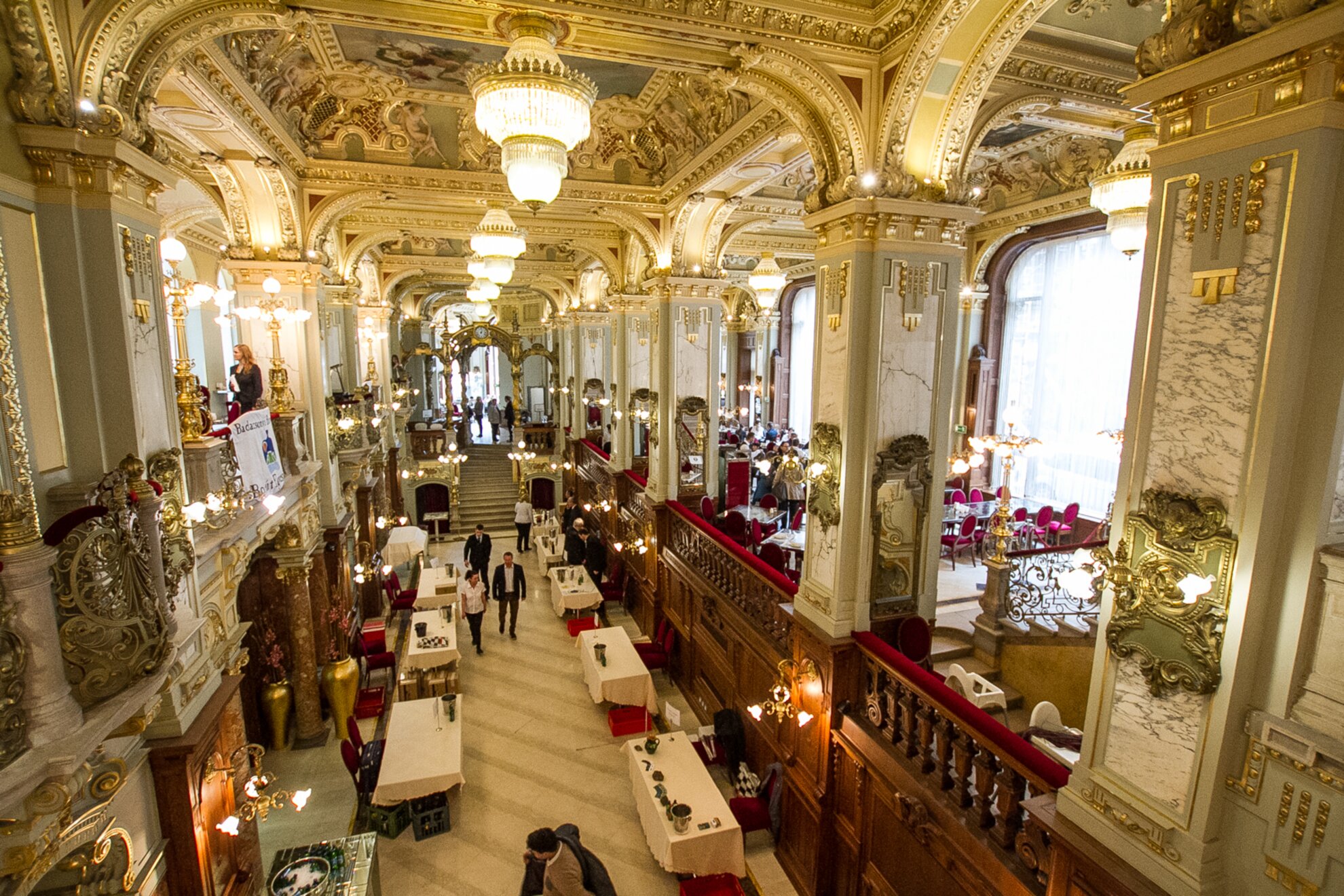Flirting with Art Nouveau but mainly created in the style of the Neo-Renaissance, the palatial New York Café was built between 1891–95 by Alajos Hauszmann, the architect who redesigned Buda Castle. The whole building, the New York Palace, was created for the New York Life Insurance Company – the café was on the ground floor. The façade immediately attracts the eye, the main door guarded by two devilish statues holding lanterns, old symbols for coffee and thought.
Around it, the Grand Boulevard was also starting to take shape. Budapest was steadily evolving into a cosmopolitan city, and this part, up until then considered the outskirts, suddenly gained prestige. Andrássy út had been established, to coincide with Hungary’s millennial celebrations, with the continent’s first underground train running below. The spirit of entrepreneurship, art and literature was at its zenith. Writers and artists would convene in Budapest’s coffeehouses. The New York Café, opening in 1894, crowned the era.
There are a number of legends surrounding this locale – the most famous is connected to writer Ferenc Molnár of Pál Street Boys fame, who allegedly threw the key to the front door into the Danube, in order to stop it from closing for the night. There are many versions of this story, while some believe that it never happened, or that it happened later with different participants. Nevertheless, the legend lives on, depicted in recent times by urban sculptor Mihály Kolodko, who created the figure of a deep-sea diver fishing the famous key out of the water.
“You, New York Coffeehouse, where I spent so many days,” proclaims one of the most prominent lights of Hungarian literature, Dezső Kosztolányi, in his poem from the 1920s. He slipped this hub of art and culture into many of his writings, including his emblematic collection of short stories, Esti Kornél. It suggest that they would offer coffee in return for poems, allowing young writers to come, dream and smoke endless cigarettes.
There were around 500 coffeehouses in Budapest at the time, meeting the needs of various social groups. Writers would spend hours sitting in cafés, each at their own favourite spots. Apart from developing friendships and producing pioneering ideas, they also wrote some of the most important pieces of art in coffeehouses.
“At the lavish New York Café, they cleaned your shoes, ironed your clothes, shaved and cut your hair even late in the evening (…) the coffeehouse was a workshop and a writing table, an apartment and a night’s lodging in harder times, as you could stay until dawn.” (Jenő Heltai, writer)
It became a literary café after 1900, thanks to its new owners, and a new head waiter, Gyula Reisz, who became close to many of the writerly regulars. The New York Café provided a number of additional services to entice writers, such as the affordable írótál (the ‘writer’s platter’, consisting of cold cuts, cheese and bread), as well as the kutyanyelv (the ‘dog’s tongue’, an elongated piece of writing paper) and ink to go with the coffee. The shelves were packed with encyclopaedias, reporter’s manuals and journals from every corner of the world. To put the icing on the cake, artists suffering after a long night received aspirins from the caring waiters.
Many of the most famous members of the number one literary journal in the history of Hungary, Nyugat, spent their days here, including Kosztolányi, Molnár and Sándor Márai. The cream of high society also frequented these tables, factory managers, bankers and aristocracy. Actors, musicians and artists of all kind, such as renowned painter Pál Szinyei Merse, sat beneath these glowing chandeliers.
The second golden age of the café was between the 1920s and ‘30s, when Vilmos Tarján introduced a kitchen to the venue, enticing the pleasure-seeking crowds from the National Casino. Tarján was marvellous character in his time. Starting his career as an investigative journalist, he was forced to change tack in the Horthy era due to an interview with the infamous Communist leader, Béla Kun. He later earned a fortune through gambling, and became an entrepreneur. Apart from hiring the New York Café and the Royal Orfeum, he also had a flair for publicity. One day he decided to invite two special guests to the café for breakfast: a seal and its handler.
A period of decay followed the end of the Tarján era, before the building suffered significant damage during World War II and was forced to make a living by selling horse meat and molasses. After 1945, the interior was refurbished, although not everyone favoured the modern redesign. Nevertheless, it was generally considered to complement the classic atmosphere of the café. The coffeehouse closed its doors in 1947, when a sports store and the national IBUSZ travel agency moved into its imposing rooms. In the 1950s, the café reopened under the name of the Hungária Kávéház, regaining its popularity among artists and the general public.

The fate of the building was again up for debate after Hungary’s régime change in 1989. Ideas included moving the National Theatre here, or turning it into a cultural centre and exhibition space.
The New York Palace was finally purchased by the Italian Boscolo Group, which resulted in the creation of a five-star luxury hotel in the building, as well as the complete renovation of the café. These opened in 2006 and became part of Boscolo’s Dedica Anthology portfolio, later sold in 2020.
The palace has now been reborn, Hungarian speakers enjoying regular literary events that honour the glorious past of the New York Café.

References
Katalin Csapó: A százéves irodalmi kávéház, a New York.
Edit Erki: Kávéház-sirató. Törzshelyek, írók, műhelyek
Magda Konrádyné Gálos: A Newyorktól a Hungáriáig
Noémi Saly: Törzskávéházamból zenés kávéházba. Séta a budapesti körutakon




